
Atlanta Braves(2)
USINFO | 2013-06-20 10:34
In October 1996, Time Warner acquired Ted Turner's Turner Broadcasting System and all of its assets, including its cable channels and the Atlanta Braves. Over the next few years, Ted Turner's presence as owner of the team would diminish.
A 95–67 record in 2000 produced a ninth consecutive division title. However, a sweep at the hands of the St. Louis Cardinals prevented the Braves from reaching the National League Championship Series [14]for a ninth consecutive time.
In 2001, Atlanta won the National League East division yet again, swept the Houston Astros in the NLDS, then lost to the Arizona Diamondbacks in the National League Championship Series four games to one. One memorable game the Braves played that year came on September 21, when they played rival New York Mets in the first major professional sporting event held in New York City since 9/11.
In 2002, 2003 and 2004, the Braves won the Eastern division again, but lost in the NLDS in all three years in the same fashion: 3 games to 2 to the San Francisco Giants, Chicago Cubs, and Houston Astros.
Cy Young dominance
Six National League Cy Young Awards in the 1990s were awarded to three Braves pitchers:
• In 1991, left-handed pitcher Tom Glavine received his first award.
• Right-handed pitcher Greg Maddux won three in a row with the Braves, from 1993 through 1995. His first award came in 1992 with the Cubs.
• In 1996, right-handed pitcher John Smoltz received his only Cy Young award.
• In 1998, Glavine won his second.
2005: A new generation
Main article: 2005 Atlanta Braves season
In 2005, the Braves won the Division championship for the fourteenth consecutive time from 1991 to 2005. Fourteen consecutive division titles stands as the record for all major league baseball. The 2005 title marked the first time any MLB team made the postseason with more than 4 rookies who each had more than 100 ABs (Wilson Betemit, Brian McCann, Pete Orr, Ryan Langerhans, Jeff Francoeur).[citation needed] Catcher Brian McCann, right fielder Jeff Francoeur, and pitcher Kyle Davies all grew up in the suburbs of Atlanta. The large number of rookies to debut in 2005 were nicknamed the "Baby Braves" by fans and became an Atlanta-area sensation, helping to lead the club to a record of 90–72.
However, the season would end on a sour note as the Braves lost the National League Division Series to the Astros in four games. In Game 4, with the Braves leading by 5 in the eighth inning, the Astros battled back with a Lance Berkmangrand slam and a two-out, ninth inning Brad Ausmus home run off of Braves closer Kyle Farnsworth. The game did not end until the 18th inning, becoming the longest game in playoff history at 5 hours 50 minutes. Chris Burke ended the marathon with a home run off of Joey Devine.
After the 2005 season, the Braves lost their long-time pitching coach Leo Mazzone, who left to go to the Baltimore Orioles. Roger McDowell took his place in the Atlanta dugout. Unable to re-sign shortstop Rafael Furcal, the Braves acquired shortstop Edgar Rentería from the Boston Red Sox.
2006: Struggles
Main article: 2006 Atlanta Braves season
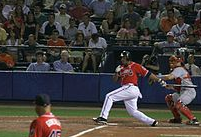
In 2006, the Braves did not perform at the level they had grown accustomed to. Due to an offensive slump, injuries to their starting rotation, and subpar bullpen performances, the Braves compiled a 6–21 record for the month of June, the worst month ever in the city of Atlanta, and just percentage points better than the Boston Braves of May 1935 (4–20).
The Braves made their move in July, going 14–10. However, the team remained in the bottom half of the NL East and trailed the Mets by a double-digit deficit for much of the season (13 games at the All-Star Break). However, despite their struggles, the Braves entered the break down by only six and a half games to the Dodgers for the NL Wild Card slot after winning seven of their last ten games.
After the break, the Braves came out with their bats swinging, setting many franchise records. They won five straight, sweeping the Padres and taking two from the Cardinals, tallying a total of 65 runs in that span. The 65 runs in five games is the best by the franchise since 1897, when the Boston Beaneaters totaled 78, including 25 in one game and 21 in another, from May 31 – June 3; the 2006 Braves also became the first team since the 1930 New York Yankees to score ten runs or more in five straight games. The Braves had a total of 81 hits during their five-game run and 98 hits in their last six games, going back to an 8–3 victory over Cincinnati on July 9, the last game before the All-Star break. Additionally, Chipper Jones was able to maintain a 20-game hitting streak and tie Paul Waner's 69-year-old Major League record with a 14-game extra-base hit streak.[16]
The Braves made their first trade of the season on July 20 to shore up the bullpen, sending Class A Rome catcher Max Ramirez to Cleveland for closer Bob Wickman. He served as the Braves' closer for the remainder of the season, taking over for an embattled Jorge Sosa, who was subsequently traded on the July 31 trade deadline for St. Louis minor league pitcher Rich Scalamandre.
On July 29, the Braves traded reserve third baseman/shortstop Wilson Betemit to the Los Angeles Dodgers for reliever Danys Báez and infielder Willy Aybar. The move came on the night that starting third baseman Chipper Jones went on the 15-day disabled list with a strained oblique muscle. With Betemit gone, the Atlanta called up infielder Tony Pena, Jr. from AAA Richmond to supplement Pete Orr.
Before the expansion of rosters on September 1, the Braves acquired Daryle Ward from the Washington Nationals for Class A Myrtle Beach pitcher Luis Atilano, in hopes that he would be a valuable pinch-hitter in the postseason.
However, on September 18, the New York Mets' win over the Florida Marlins mathematically eliminated the Braves from winning the NL East, ending the Atlanta Braves' eleven-year reign over the NL East. On September 24, the Braves' loss to the Colorado Rockies mathematically eliminated the Braves from winning the NL Wild Card, making 2006 the first year that the Braves would not compete in the postseason since 1990, not counting the strike-shortened 1994 season.
Also, a loss to the Mets on September 28 guaranteed the Braves their first losing season since 1990. Although the Braves won two of their last three games against the Astros, including rookie Chuck James besting Roger Clemens, Atlanta finished the season in third place, one game ahead of the Marlins, at 79–83.
After the season, the Atlanta coaching staff underwent a few changes. Brian Snitker became the third base coach after Fredi González left to become the manager for the Florida Marlins. Chino Cadahia replaced Pat Corrales as bench coach and former catcher Eddie Pérez became the new bullpen coach, replacing Bobby Dews.
Sale to Liberty Media
In December 2005, team owner Time Warner, who inherited the Braves after purchasing TBS in 1996, announced it was placing the team for sale.[17][18] Liberty Media began negotiations to purchase the team.
In February 2007, after more than a year of negotiations, Time Warner agreed to a deal that would sell the Braves to Liberty Media Group (a company which owned a large amount of stock in Time Warner, Inc.), pending approval by 75 percent of MLB owners and the Commissioner of Baseball, Bud Selig. The deal included the exchange of the Braves, valued in the deal at $450 million, a hobbyist magazine publishing company, and $980 million cash, for 68.5 million shares of Time Warner stock held by Liberty Media, then worth approximately $1.48 billion. Team President Terry McGuirk anticipated no change in the current front office structure, personnel, or day-to-day operations of the Braves. Liberty Media is not expected to take any type of "active" ownership in terms of day to day operations.[19]
On May 16, 2007, Major League Baseball's owners approved the sale of the Braves from Time Warner to Liberty Media.[20]
2007: More struggles
Main article: 2007 Atlanta Braves season
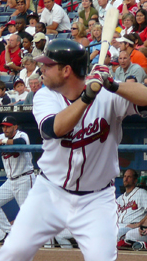
The Braves made their first moves by re-signing Bob Wickman to a one-year deal and picking up John Smoltz's option in September 2006. They traded starting pitcher Horacio Ramírez to the Seattle Mariners for pitcher Rafael Soriano, an American League reliever with a 2.20 ERA in 2006. They also denied arbitration to pitcher Chris Reitsma and second baseman Marcus Giles. The Braves signed utility-man Chris Woodwardto fill a spot on the bench. The biggest trade in the offseason involved first baseman Adam LaRoche and a minor league player for Pittsburgh Pirates closer Mike González and a minor league infielder, Brent Lillibridge. Gonzalez, who converted 24 of 24 save opportunities in 2006, joined Soriano as a set-up man for Wickman in the bullpen. The team then signed Craig Wilson to a one-year deal to platoon with Scott Thorman. The Braves also had solid relievers in Macay McBride, Blaine Boyer, and Tyler Yates. In addition, the majority of the Braves' offense, which was second in the NL in runs scored in 2006, returned in 2007. However, Mike Hampton was sidelined for the entire 2007 season with yet another surgery. Mike González was later sidelined for the season while recovering from Tommy John surgery.
The Braves' bullpen and offense came through in the clutch early on, helping the Braves to a 7–1 start, their best start since winning the World Series in 1995. The team finished April with a 16–9 record, but struggled during May, finishing 14–14. The Braves also struggled during interleague play, finishing with an NL-worst 4–11 record. On June 24, the Braves fell to .500 for the first time in the 2007 season, but rebounded by winning the next 5 games.
On July 5, Chipper Jones surpassed Dale Murphy for the Atlanta club record of 372 home runs by belting two against the Los Angeles Dodgers. On July 31, 2007, the Braves finalized the deal to acquire slugger first baseman Mark Teixeira and LHP Ron Mahay from the Texas Rangers for catcher Jarrod Saltalamacchia, SS Elvis Andrus, and three minor-leaguers.[21] The Braves also acquired Octavio Dotel from the Kansas City Royals for Kyle Davies and also traded LHP Wilfredo Ledezma and RHP Will Startup to the San Diego Padres for Royce Ring. On August 19, 2007 John Smoltz passed Phil Niekro for 1st place on the Braves' all-time strikeout list. Braves manager Bobby Cox broke the all-time MLB record for most career ejections by a manager in August 2007.[22]
After struggling during the second half of the 2007 season, Atlanta finished over .500 and missed the post season again. On October 12, 2007, John Schuerholz stepped down as General Manager to take over as team president.[23] Assistant GM Frank Wren took over as General Manager.
2008: Injury plagued
Main article: 2008 Atlanta Braves season
In December 2007, the team announced it would not re-sign center fielder Andruw Jones (who later would sign with the Dodgers).[24] Another major move was acquiring CF Gorkys Hernández and RHP Jair Jurrjens from the Detroit Tigers in exchange for SS Edgar Rentería and cash considerations. Next, LHP Tom Glavine was signed to a one-year contract.[25] They also acquired LHP Will Ohman and INF Omar Infante from the Cubs in exchange for RHP José Ascanio.
The team's first new move for 2008 was acquiring OF Mark Kotsay from the A's (to replace Jones) in exchange for RHP Joey Devine, RHP Jamie Richmond and cash considerations. Days later, Wren traded Willy Aybar, outfielder Tom Lindsey, and infielder Chase Fontaine to the Rays in exchange for left-hand reliever Jeff Ridgway.
Before the trade deadline the Braves traded 1B Mark Teixeira to the Los Angeles Angels for first baseman Casey Kotchman and minor league RHP Stephen Marek.[26] The Braves failed to make the playoffs for the third straight season.
2009: The return of solid pitching
Main article: 2009 Atlanta Braves season
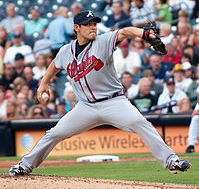
On December 4, 2008, the Atlanta Braves received Javier Vázquez and Boone Logan, while the Chicago White Sox received prospects catcher Tyler Flowers, shortstop Brent Lillibridge, third baseman Jon Gilmore and pitcher Santos Rodriguez.[27] On January 13, 2009, the Braves signed Japanese pitcher Kenshin Kawakami to a three-year deal, and two days later signed free agent pitcher Derek Lowe to a four-year contract. During the course of the offseason, the Braves signed veteran pitcher and former Brave Tom Glavine, while losing long-time Brave John Smoltz to the Boston Red Sox.
On February 25, 2009, just before the start of spring training, Atlanta agreed to terms on a one-year contract with free-agent outfielder Garret Anderson. The additional outfield depth allowed the Braves to trade Josh Anderson to the Detroit Tigers for minor league pitcher Rudy Darrow on March 30, 2009.[28]
On June 3, 2009, the Braves acquired Nate McLouth from the Pittsburgh Pirates for prospects Jeff Locke, Charlie Morton and Gorkys Hernández. They also released veteran pitcher Tom Glavine. On July 10, 2009, the Braves traded outfielder Jeff Francoeur to the New York Mets for outfielder Ryan Church. On July 31, 2009, hours before the trade deadline, the Braves and Boston Red Sox swapped 1st basemen: Atlanta dealt Casey Kotchman to Boston and reacquired Adam LaRoche, whom the Braves had traded away during the 2006–07 off-season to Pittsburgh.
The Braves made a late-season surge, coming within 2 games of the wild card leading Colorado Rockies in late September. On October 1, 2009 with the Braves four games back, Colorado beat the Milwaukee Brewers 9–2 to clinch the wild card spot and end the Braves' 2009 postseason hopes.
2010: Cox's final season
Main article: 2010 Atlanta Braves season
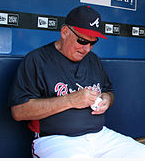
The 2010 Atlanta Braves Season features the Braves' attempt to reclaim a postseason berth for the first time since 2005. The Braves were once again skippered by Bobby Cox, now in his 25th and final season managing the team. The Braves started the 2010 season slowly and had a nine-game losing streak in April. Then they had a nine-game winning streak from May 26 through June 3, the Braves longest since 2000 when they won 16 in a row. On May 31, the Atlanta Braves defeated the then-first place Philadelphia Phillies at Turner Field to take sole possession of first place in the National League East standings, a position they had maintained through the middle of August.[29] The last time the Atlanta Braves led the NL East on August 1 was in 2005. On July 13, 2010 at the 2010 MLB All-Star Game in Anaheim, Braves catcher Brian McCann was awarded theAll-Star Game MVP Award for his clutch two-out, three-run double in the seventh inning to give the National League its first win in the All-Star Game since 1996.[30] He became the first Brave to win the All-Star Game MVP Award since Fred McGriff did so in 1994. The Braves made two deals before the trade deadline to acquire Álex González, Rick Ankiel and Kyle Farnsworth from the Toronto Blue Jays and Kansas City Royals, giving up shortstop Yunel Escobar, pitchers Jo-Jo Reyes and Jesse Chavez, outfielder Gregor Blanco and three minor leaguers.[31][32] On August 18, 2010 they traded three pitching prospects for first baseman Derrek Lee from the Chicago Cubs.[33] On August 22, 2010 against the Chicago Cubs, Mike Minor struck out 12 batters across 6 innings; an Atlanta Braves single game rookie strikeout record.[34] The Braves dropped to second in the NL East in early September, but won the NL Wild Card. They lost to the San Francisco Giants in the National League Division Series in four games. Every game of the series was determined by one run. After the series-clinching victory for the Giants in Game 4, Bobby Cox was given a standing ovation by the fans, also by players and coaches of both the Braves and Giants.
2011: Fredi González era
Main article: 2011 Atlanta Braves season
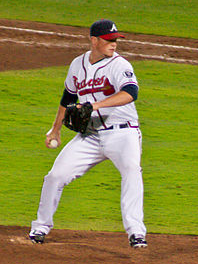
On October 13, 2010, the Atlanta Braves announced that Fredi González would replace long-time Braves manager Bobby Cox as manager of the team in 2011.[35] The announcement came just two days after the 2010 Braves were eliminated from the postseason. It was also announced that pitching coach Roger McDowell, third-base coach Brian Snitker, and bullpen coach Eddie Pérez would retain their current positions, while former hitting coach Terry Pendleton would replace Glenn Hubbard as the first-base coach and newcomer Carlos Tosca would become the new bench coach. Hubbard and former bench coach Chino Cadahia were not offered positions on the new coaching staff. Larry Parrish was hired as hitting coach on October 29, 2010.
On November 16, 2010 in an offseason trade, the Braves acquired Dan Uggla from the Florida Marlins in exchange for left-handed reliever Mike Dunn and infielder Omar Infante. According to Elias Sports Bureau, the Braves had an all-time franchise win-loss record over .500 for the first time since 1923 after their win over the Houston Astros on June 11, 2011.[36] The Braves franchise became the third franchise in MLB history to reach 10,000 wins with their win over the Washington Nationals on July 15, 2011.[37] On July 31, 2011, just sixteen days after registering their 10,000th win, the Florida Marlins defeated the Braves by a score of 1-3, handing the team the 10,000th loss in franchise history. The Braves become only the second team in big league history with 10,000 losses after thePhiladelphia Phillies reached the plateau in 2007.[38]
Players from the Braves' farm system, such as Freddie Freeman and Brandon Beachy, played regularly with the big league club, while Julio Teherán, Randall Delgado, and Mike Minor were called up for spot starts. With late season injuries to starters Jair Jurrjens and Tommy Hanson, these three young pitchers made their way into the starting rotation in their absence.[39] Eight players made their major league debuts for the team in 2011.
September collapse
The Braves led the National League Wild Card standings for much of the 2011 season, with the division-rival Philadelphia Phillies firmly in control of first place in the National League East. The Braves entered the final month of the regular season 25 games above .500 with a record of 80–55 and an 8 1⁄2-game lead in the Wild Card standings. The nearest team trailing them, the St. Louis Cardinals, who also trailed the National League Central-leading Milwaukee Brewers by 8 1⁄2 games at the time, were considered a long-shot to gain a spot in the postseason. Just days prior on August 26, the Cardinals found themselves 10 1⁄2 games behind and in third place.[40]
With 27 games to play, the Braves went 9–18 in September to finish the season with a record of 89–73. The Cardinals, meanwhile, went 18–8 to finish at 90–72. Braves closer Craig Kimbrel, who had not surrendered a single earned run in July or August, carried a 4.76 ERA in September with three blown saves. After being dominant in his role for much of the season, Braves setup man Jonny Venters posted a 5.11 September ERA. These sharp declines in both relievers led many critics to question the handling of the bullpen by Braves manager Fredi González.[41] Veteran starter Derek Lowe posted a win-loss record of 0–5 in September with an ERA of 8.75.[42] Shortly into the offseason, Lowe would be traded to theCleveland Indians.[43] The Braves starters lasted six or more innings only three times over the last 23 games.[42] Over the last five games, all of which were losses for the Braves, the team managed to score only seven runs.[44] Braves catcher Brian McCann, often regarded as the best offensive catcher in the Majors, hit only .183 with two home runs in September.[42] The offense as a whole hit for only a .235 batting average and a .300 on-base percentage in September, both second-worst in the National League. The .195 RISP average by Braves hitters was second worst in the Majors.[42] Hitting coach Larry Parrish was fired two days following the last game of the season.[45]
2012
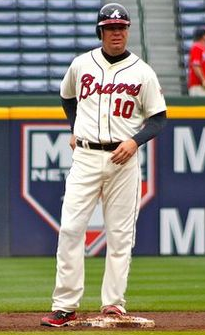
Main article: 2012 Atlanta Braves season
In 2012, the Braves began their 138th season after an upsetting end to the 2011 season. On March 22, the Braves announced that third baseman Chipper Jones would retire following the 2012 season after 19 Major League seasons with the team. The Braves also lost many key players through trades or free agency, including pitcher Derek Lowe, shortstop Alex González, and outfielder Nate McLouth. To compensate for this, the team went on to receive many key players such as outfielder Michael Bourn, along with shortstops Tyler Pastornicky and Andrelton Simmons. To fill the void of a quality starting pitcher left by Lowe (as well as a mid-season injury to Brandon Beachy), manager Fredi González elected relief pitcher Kris Medlen to the starting pitching rotation. The Braves went on to win every game Medlen started, setting the MLB record for most consecutive wins when a single pitcher starts (total of 23). Atlanta stayed close to the Washington Nationals in the race to win the National League East title. They also stayed on top of the National League Wild Card race. Washington ended up winning their first division title in franchise history, but the Braves remained in first place of the NL wild card race. Keeping with a new MLB rule for the 2012 season, the top two wild card teams in each league must play each other in a playoff game before entering into the Division Series.
The Braves played the Saint Louis Cardinals in the first ever Wild Card Game. The Braves were behind 6–3 in the bottom of the eighth inning when Andrelton Simmons hit a fly ball to left field that dropped in between the Cardinals shortstop and left fielder. Umpire Sam Holbrook called Simmons out, citing the infield fly rule. Had an infield fly not been called, Simmons would have been credited with a single and Atlanta would have had the bases loaded with one out. Fans at Turner Field began to litter the field with debris, prompting the game to be delayed for 19 minutes. The Braves lost the game 6–3, ending their season.
For a full season-by-season list, see List of Atlanta Braves seasons.
Major rivalries
New York Mets
Main article: Braves–Mets rivalry
The Braves–Mets rivalry is a rivalry between the two teams, featuring the Braves and the New York Mets as they both play in the National League East.[13]
Although their first major confrontation occurred when the Mets swept the Braves in the 1969 National League Championship Series, en route to their first World Series championship, the first playoff series won by an expansion team (also the first playoff appearance by an expansion team), the rivalry did not become especially heated until the 1994 season when division realignment put both the Mets and the Braves in the NL East division.[12][46] During this time the Braves became one of the most dominant teams in professional baseball, earning 14 straight division titles through 2005, including five world series berths, and one world series championship during the 1995 season.
Philadelphia Phillies
While their rivalry with the Philadelphia Phillies lacks the history and hatred of the Mets, it has been the more important one in the last decade. Since the 1993 season, the two teams have reigned almost exclusively as NL East champions, the exceptions being in 2006, when the Mets won their first division title since 1988 (no division titles were awarded in 1994 due to the player's strike), and in 2012, when the Washington Nationals claimed their first division title since 1981 when playing as the Montreal Expos. The Phillies 1993 championship was also part of a four-year reign of exclusive division championships by the Phillies and the Pittsburgh Pirates, their in-state rivals.[47] While rivalries are generally characterized by mutual hatred, the Braves and Phillies deeply respect each other. Each game played (18 games in 2011) is vastly important between these two NL East giants, but at the end of the day, they are very similar organizations.[48] Overall, the Braves and the Phillies are tied for the most National League East division titles, having won 11 times each since 1969, with the Braves holding it for eleven consecutive years from 1995 through 2005.
Uniforms
The Braves currently have five different game baseball uniform combinations. The home uniforms consist of a standard white uniform, an alternate red jersey worn with the standard white pants, and a cream alternate uniform. The road uniforms consist of a standard gray uniform, and an alternate navy blue jersey worn with the standard gray pants.
The white home uniform, introduced in 1987, is the primary home uniform. The jersey has "Braves" written in script across the breastplate with the tomahawk logo underneath. The jersey also includes piping around the collar and down the front of the jersey and around the bottom of the sleeves. Player numbers appear on the back of the jersey with a nameplate above. The Braves script, player numbers, and piping are red with a navy blue border. The tomahawk is primarily red with blue and yellow detail and a navy blue border. The white pants have identical piping to the jersey about the belt loops and down the outside seam of the pants. The player names consist of navy blue lettering sewn to a white nameplate. The player names originally used vertically arched lettering but, since 2006, the team has used radially arched lettering. The white uniform is paired with the standard home cap. It is a red brimmed, navy blue cap with a white embroidered "script A" logo. The home batting helmet is identical to the primary home cap.
The red jerseys are worn with the white pants and include the same elements as the white jerseys. The Braves script, player numbers, and piping are navy blue with a white border. The tomahawk is primarily blue, with red and yellow detail and a white border. The player names consist of white lettering sewn to a red nameplate. The red jerseys are paired with an alternate home cap, which is a red brimmed, navy blue cap with a red, embroidered "script A" logo with a tomahawk, outlined in white. The alternate cap does not have a matching batting helmet. Introduced in 2005, the red jerseys were originally worn for Sunday home games. The only exceptions to this were the opening game of the 2005 NLDS, which was played on a Wednesday, and on Memorial Day in 2006. The 2006 Memorial Day game is also the only time the red jerseys were paired with the primary home cap. With the introduction of the cream uniform in 2012, the red jerseys will be worn for Friday night home games. However, the Braves chose to wear the traditional white jerseys for their 2012 home opener, which took place on Friday, April 13.
The cream alternate uniforms were introduced in February 2012 as a tribute to the Braves' first season in Atlanta in 1966. The jersey includes the "Braves" script across the breastplate, but the player number replaces the tomahawk underneath the "Braves" script on the left placket. Player numbers and the "Braves" script are in red with a navy blue border. The player names consist of navy blue lettering sewn to a cream nameplate. The jersey has a thin, navy piping about the collar and down the front of the jersey. There is no piping around the sleeves. The cream pants include piping identical to the jersey down the outside seam. The left sleeve of the jersey has a "crossed tomahawk" logo that replaces the "screaming Indian" logo that appeared on the 1966 jerseys. The new logo has two, primarily red, crossed tomahawks. Underneath the tomahawks is a blue circle outlined in red, with "1876" in red above (commemorating the year the franchise was founded), and "Atlanta Braves" in white below. The cream uniforms are paired with the standard home cap and are worn for Saturday and Sunday home games.
The gray road uniforms are the primary road uniform. The uniforms are identical to the white home uniforms with the exception of the "Braves" script, which is replaced by the "Atlanta" script. Player names are sewn to a gray nameplate.
The alternate navy blue road jerseys were introduced on opening night of the 2008 season against the Washington Nationals. Worn with the gray road pants, the jerseys feature the "Atlanta" script on the breastplate in navy blue with a white outline. The tomahawk is primarily navy blue with red and yellow detail and a white border. The player numbers are blue with white borders and the player names are white letters sewn to a navy blue nameplate. The navy blue jerseys have no piping either on the sleeves or around the collar.
From 1987 to 2008, the red brimmed, primary home cap was also worn on the road. However, when the navy blue jerseys were introduced in 2008, they were paired with a navy blue cap, similar to the team's road cap worn from 1966 to 1971. While the red brimmed cap was still primarily worn with the gray road uniforms, the team sometimes wore the navy blue cap with the gray jerseys, and the red brimmed cap was occasionally worn with the navy blue jerseys. The red brimmed home batting helmets were also worn on the road from 1987 through 2008. Beginning in 2009, the navy blue cap became the official road cap and was paired with a navy blue road batting helmet.
Unlike the home uniforms, which are worn based on a schedule, the road uniforms are chosen on game day by the starting pitcher. However, they are also subject to Major League Baseball rules requiring the road team to wear uniforms that contrast with the uniforms worn by the home team. Due to this rule, the gray uniforms are worn when the home team chooses to wear navy blue, and sometimes when the home team chooses to wear black.
Share this page



















